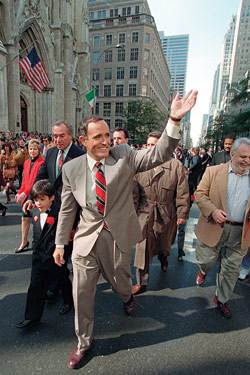 |
(Photo: Michael Albans/AP) |
The version of history that goes down as conventional wisdom rarely reflects the complexity of what actually happened. As the years pass, the newspapers condense the narrative into digestible shorthand. The winners get to keep repeating their version on television and in books, while the losers have no forum. Our memories play tricks on us. The recent, lived past is a palimpsest—the older memories remain partly visible but are obscured and changed by fresher ones.
So, when we think of Rudy Giuliani taking over New York City in January 1994, I suspect that many of us tend to think: a city starving for change; a populace placing great faith in the confident, adamantine new mayor as the agent of that change. But actually, neither of these things was quite true.
The city was not starving for change. Bad as the previous four years were—about 1,700 private-sector jobs lost every week on average, homicides surpassing 2,000 per year, more than 1 million residents on welfare—just about half the city was reluctant to give up on its first black mayor, and the voters in November 1993 ratified change only grudgingly. Incumbent David Dinkins was widely seen as ineffectual, but out of 1.75 million votes cast, in so heavily Democratic a town, Giuliani won by just 50,000. If not for the presence on the ballot of a Staten Island secession referendum, which brought the Rudy-friendly voters of Richmond County to the polls in large numbers, he would have lost.
Second, and this is something that’s harder to imagine today, a fair number of people thought: so what? The city was, in the oft-used word of the day, ungovernable. Unsalvageable. The economy was a wreck. Nothing the city did seemed to work. Social indicators were uniformly bleak. In 1993, for the first time, a majority of births in the city were delivered to unmarried mothers. A majority! Also: the drug dealers in the parks. The squeegee men. The homeless. Larry Hogue (no, Google him yourself).
Identity politics run amok. Crown Heights. The Korean-deli boycott. The Rainbow Curriculum (Google it too while you’re at it). You know what I still have on my bookshelf? The first-edition printings of Heather Has Two Mommies and its much less famous companion piece (at least until word surfaced that Sarah Palin had found it unsuitable for the shelves of Wasilla’s library, vastly increasing its eBay value), Daddy’s Roommate. I always thought they’d retain currency value, like records of a lost civilization, written on a faded codex.
No less a savant of urbanism than Daniel Patrick Moynihan, that great liberal and occasional neoconservative who never abandoned his nostalgia for Tammany’s no-nonsense efficiency (“We built the entire Bronx-Whitestone Bridge in 31 months!” he once barked to me), saw nothing but discouraging signs. I remember with crystal clarity the speech he gave to Lew Rudin’s Association for a Better New York in the spring of the 1993 election year. New Yorkers, he said, had withdrawn into “a narcoleptic state of acceptance” of a host of quality-of-life ills and annoyances. The following year, shortly after Giuliani had taken office, Moynihan told a city hearing on juvenile violence that the rate of out-of-wedlock births essentially ensured that the city’s youth was lost for years to come: “The next two decades are spoken for … There is nothing you’ll do of any consequence, except start the process of change. Don’t expect it to take less than 30 years.”
No one quite understood the force of the tornado that had just hit town. By the end of Giuliani’s first year, the city was a visibly different place—made safe, Toronto-ized, starting down the road toward being Olive Garden–ized (yes, there were downsides!); a place that suddenly was no longer the city where Travis Bickle prayed to God for the rain to wash the trash off the sidewalk and where—in real life, not the movies—display ads for porn films actually ran in the Post right alongside the display ads for Smokey and the Bandit (it’s true; a few years ago I went to the Post’s morgue and looked through old issues and saw the ads, and their blurbs screaming “Full Erection!,” with my own disbelieving eyes). That is inconceivable to us now. But it, and a score of cankers like it, used to be the reality in New York. Lots of forces combined to change that, but the biggest force of all was Rudy.
In the intervening years, Giuliani has had his ups and downs. Arguably more downs, at least numerically. Yes, there was the leadership and staggering humanity on display in his response to the September 11 attacks, which counts for a lot. But there was the train wreck of his presidential candidacy. And the train wreck of his Senate candidacy in 2000, which was headed in the wrong direction before his prostate-cancer diagnosis gave him a reason to drop out and focus on his health. The marriages. Judi—yikes! The sometimes unhinged attacks on victims of police shootings. Do you recall the name of Patrick Dorismond, whose sealed juvenile record the mayor ordered released? He was, Rudy said, “no altar boy”—except that he had been, literally. The second-term jihad against hot-dog vendors and jaywalkers.

